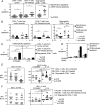Early establishment and antigen dependence of simian immunodeficiency virus-specific CD8+ T-cell defects
- PMID: 17670818
- PMCID: PMC2045568
- DOI: 10.1128/JVI.00813-07
Early establishment and antigen dependence of simian immunodeficiency virus-specific CD8+ T-cell defects
Abstract
Differentiation and survival defects of human immunodeficiency virus (HIV)-specific CD8(+) T cells may contribute to the failure of HIV-specific CD8(+) T cells to control HIV replication. It is not known, however, whether simian immunodeficiency virus (SIV)-infected rhesus macaques show comparable defects in these virus-specific CD8(+) T cells or when such defects are established during infection. Peripheral blood cells from acutely and chronically infected rhesus macaques were stained ex vivo for memory subpopulations and examined by in vitro assays for apoptosis sensitivity. We show here that SIV-specific CD8(+) T cells from chronically SIV infected rhesus macaques show defects comparable to those observed in HIV infection, namely, a skewed CD45RA(-) CD62L(-) effector memory phenotype, reduced Bcl-2 levels, and increased levels of spontaneous and CD95-induced apoptosis of SIV-specific CD8(+) T cells. Longitudinal studies showed that the survival defects and phenotype are established early in the first few weeks of SIV infection. Most importantly, they appear to be antigen driven, since most probably the loss of epitope recognition due to viral escape results in the reversal of the phenotype and reduced apoptosis sensitivity, something we observed also for animals treated with antiretroviral therapy. These findings further support the use of SIV-infected rhesus macaques to investigate the phenotypic changes and apoptotic defects of HIV-specific CD8(+) T cells and indicate that such defects of HIV-specific CD8(+) T cells are the result of chronic antigen stimulation.
Figures




References
-
- Allen, T. M., D. H. O'Connor, P. Jing, J. L. Dzuris, B. R. Mothe, T. U. Vogel, E. Dunphy, M. E. Liebl, C. Emerson, N. Wilson, K. J. Kunstman, X. Wang, D. B. Allison, A. L. Hughes, R. C. Desrosiers, J. D. Altman, S. M. Wolinsky, A. Sette, and D. I. Watkins. 2000. Tat-specific cytotoxic T lymphocytes select for SIV escape variants during resolution of primary viraemia. Nature 407:386-390. - PubMed
-
- Allen, T. M., J. Sidney, M. F. del Guercio, R. L. Glickman, G. L. Lensmeyer, D. A. Wiebe, R. DeMars, C. D. Pauza, R. P. Johnson, A. Sette, and D. I. Watkins. 1998. Characterization of the peptide binding motif of a rhesus MHC class I molecule (Mamu-A*01) that binds an immunodominant CTL epitope from simian immunodeficiency virus. J. Immunol. 160:6062-6071. - PubMed
-
- Arnoult, D., F. Petit, J. D. Lelievre, D. Lecossier, A. Hance, V. Monceaux, B. Hurtrel, R. Ho Tsong Fang, J. C. Ameisen, and J. Estaquier. 2003. Caspase-dependent and -independent T-cell death pathways in pathogenic simian immunodeficiency virus infection: relationship to disease progression. Cell Death Differ. 10:1240-1252. - PubMed
-
- Barouch, D. H., J. Kunstman, J. Glowczwskie, K. J. Kunstman, M. A. Egan, F. W. Peyerl, S. Santra, M. J. Kuroda, J. E. Schmitz, K. Beaudry, G. R. Krivulka, M. A. Lifton, D. A. Gorgone, S. M. Wolinsky, and N. L. Letvin. 2003. Viral escape from dominant simian immunodeficiency virus epitope-specific cytotoxic T lymphocytes in DNA-vaccinated rhesus monkeys. J. Virol. 77:7367-7375. - PMC - PubMed
-
- Champagne, P., G. S. Ogg, A. S. King, C. Knabenhans, K. Ellefsen, M. Nobile, V. Appay, G. P. Rizzardi, S. Fleury, M. Lipp, R. Forster, S. Rowland-Jones, R. P. Sekaly, A. J. McMichael, and G. Pantaleo. 2001. Skewed maturation of memory HIV-specific CD8 T lymphocytes. Nature 410:106-111. - PubMed
Publication types
MeSH terms
Substances
Grants and funding
LinkOut - more resources
Full Text Sources
Research Materials

